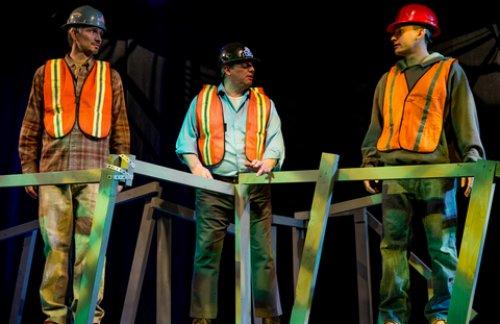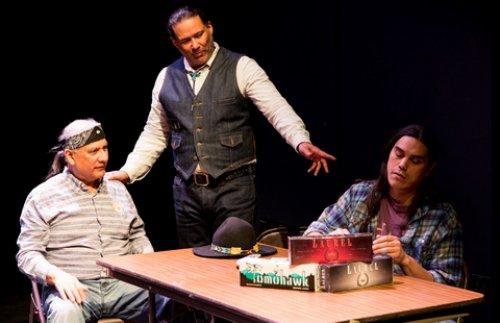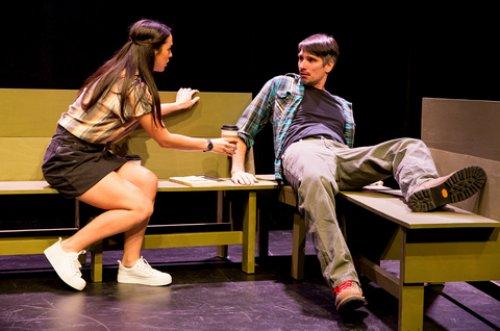Mangled Beams
The sad plight of Native American construction workers in NYC just before, during and after 9/11 is dramatized in this ambitious documentary play.

Denny Desmarais, Mike Pirozzi and Greg Seage in a scene from Dawn Jamieson’s “Mangled Beams” (Photo credit: Isaiah Tanenbaum)
[avatar user=”Darryl Reilly” size=”96″ align=”left” ] Darryl Reilly, Critic[/avatar]Discrimination against Native Americans and exploring their culture in the contemporary United States are the subjects of playwright Dawn Jamieson’s informative, noble and affective drama Mangled Beams. Its didactic streak and overloaded exposition to establish the seven characters prevent it from totally succeeding. The focus is on Native-Americans who have left their upstate New York reservation to seek construction work in the city.
On September 11, 2001 at 7:45 AM, we’re in the hiring room of an ironworker’s union hall in New York City. The crusty Sal is the middle-aged Italian-American foreman with racist tendencies who calls the names of the lucky few to be sent out for short term jobs. The rest of the characters are all Native-Americans, the majority of which are iron workers.
Alcoholic Brad in his 40’s is a life-long iron worker and wracked with despair over his troubled home life and lack of opportunity. Dave is his fiery younger brother who has spent time in prison. Greg is in his 20’s and is struggling to build a successful future for himself. Becky is Brad’s niece and Greg’s girlfriend. Jess is a roughish wheeler dealer. Fern is Brad’s estranged wife who has a public radio show where she broadcasts about Native-American issues. Joe is Greg’s distant father and is a cigarette smuggling magnate.
During the first act, we learn all about everyone’s aspirations and problems through interactions and flashbacks. The second act takes place after the destruction of the World Trade Center. Labor conflicts are suspended as everyone is needed to help with the clean-up.

Joe Cross, John Scott-Richardson and Dylan Carusona in a scene from Dawn Jamieson’s “Mangled Beams” (Photo credit: Isaiah Tanenbaum)
Ms. Jamieson’s dialogue straightforwardly fleshes out each character. Their backstories and personal details are imparted with heartfelt descriptiveness. The approach of having the characters caught up in real events adds drama to the premise. However, there is also repetitiveness, tangents and packing in too much information that hinder the play’s flow.
Mangled Beams is presented by AMERINDA which stands for American Indian Artists Inc. and was founded in 1987. It is a New York City based “organization specifically advocating for the inclusion of the indigenous perspective in the arts and cultural equity in public policy… giving voice and making visible traditional and contemporary forms of Native American expressions.”
Director Christen Omantra Callahan’s focused staging injects as much momentum as possible to the stilted script and guides the cast to expressive performances. That most of them are Native American adds a layer of authenticity.
With his aching vocal delivery, sorrowful countenance and emotional volatility, Denny Desmarais is the heart and soul of the play in the leading role of Brad. The seasoned Mike Pirozzi, though suitably despicable as Sal, wonderfully humanizes this villain especially in the second act as he sets aside his prejudices.
Dylan Carusona as Dave, Maeve Crispi as Becky, Joe Cross as Jess, Erin Kelley as Fern, John Scott-Richardson as Joe and Greg Seage as Greg all offer strong characterizations and have moments of glory.

Maeve Crispi and Denny Desmarais in a scene from Dawn Jamieson’s “Mangled Beams” (Photo credit: Isaiah Tanenbaum)
Scenic designer Dedalus Wainwright utilizes a simple assortment of benches and office furniture for the first act. For the second, Mr. Wainwright creates a configuration of gray wood platforms and beams representing Ground Zero that adds an impressive visual and symbolic scope to the small-scale production.
Elijah J. Schreiner’s lighting design starkly illuminates the actions with interludes of moody dimness for the flashbacks. Z Worthington’s sound design crisply renders the incidental music and effects. Most haunting are rescue dogs barking as they discover police pretending to be survivors. The dogs had been depressed at having only found dead bodies and this ruse cheered them up.
Costume designer Kyle LeMaire contributes a realistic assortment of jeans, plaid shirts and everyday wear that is accentuated by hard hats and orange vests.
Though earnest, passionate and involving, Mangled Beams doesn’t quite cohere into a fully realized theatrical work.
Mangled Beams (through April 29, 2018)
American Indian Artists Inc. (AMERINDA)
Jeffrey and Paula Gural Theatre at The A.R.T./New York Theatres
302 West 53rd Street, in Manhattan
For tickets, call 800-838-3006 or visit http://www.amerinda.org
Running time: two hours including one intermission






you were generous, as a drama critic as well, I thought this show had nothing to it.